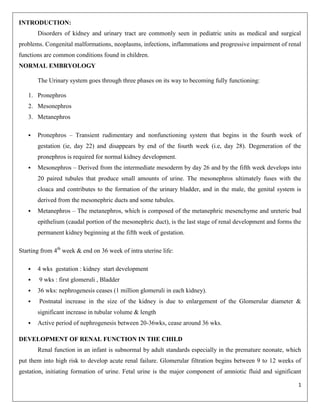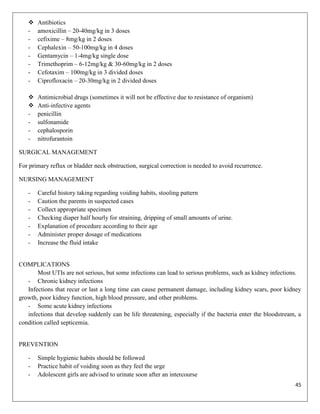The document discusses disorders of the kidney and urinary tract in pediatric patients, outlining their common congenital malformations, infections, and surgical issues. It details the embryological development of the urinary system, renal anatomy, physiology, and the functions of the renal system, including excretion, homeostatic regulation, and endocrine functions. Additionally, it emphasizes the importance of diagnostic evaluations, physical examinations, and clinical features of renal diseases in children.



































































![History of kidney stones
Children who have had a kidney stone in the past have the highest risk of developing a stone in
the future. Preventive measures can decrease the risk of developing a stone in the future.
Less water intake
The amount of fluids a child drinks directly affects the amount of urine the body makes.
Drinking a small amount of fluids means that the kidneys make a small amount of urine, which increases
the concentration of stone-forming substances in the urine. Drinking more fluids can reduce the risk of
recurrent stones.
Ketogenic diet
Diets that include a very small amount of carbohydrates, called ketogenic diets, can increase the
risk of developing kidney stones. Ketogenic diets are sometimes used to treat seizure disorders.
Urinary tract abnormalities
Congenital abnormalities in the kidneys, ureters, or bladder can increase the risk of developing a
kidney stone.
Medicines
Some medicines increase the risk of forming crystals in the urine. These include furosemide
(Lasix), acetazolamide (Diamox), and allopurinol (Aloprim, Zyloprim).
Inherited disorders
Several uncommon inherited disorders can increase a child's risk of developing kidney stones.
MANAGEMENT
HOME
If the stone is small, pain is manageable, and the child is otherwise healthy, it is often possible to treat
the stone at home. Stones smaller than 5 millimeters (0.2 inches) often pass on their own without treatment.
Pain management should be done with the help of analgesics. The child should also drink more fluids than usual
to help flush the stone out.
HOSPITAL
In some cases, the child will need to be hospitalized for treatment. The two most common reasons for
hospitalization are that:
The stone is blocking the urinary tract, preventing the normal flow of urine. If the blockage is not treated
quickly, it can cause permanent damage to the kidneys.
The child's pain cannot be controlled because it is severe or because the child is vomiting.
-
Analgesia
Management of pain often requires intravenous administration of NSAIDs or opioids.[1] Orally
administered medications are often effective for less severe discomfort.
-
Expulsion therapy
The use of medications to speed the spontaneous passage of ureteral calculi is referred to as medical
expulsive therapy. Several agents, including alpha adrenergic blockers (such as tamsulosin) and calcium
68](https://image.slidesharecdn.com/renalsystemcomplete-131031080613-phpapp02/85/Renal-system-complete-68-320.jpg)










![e) Hyperphosphatemia
f) Pulmonary edema and CCF
METHODS OF DIALYSIS
1. Hemodialysis
2. Peritoneal dialysis
Continuous ambulatory peritoneal dialysis
Automated peritoneal dialysis (Continuous cycling peritoneal dialysis)
3. Continuous renal replacement therapies
Continuous venovenous hemofiltration
Continuous venovenous hemodialysis
Continuous venovenous hemodiafiltration
1.Hemodialysis
Pediatric hemodialysis is referred to extracorporeal renal replacement therapy in children under the age
of 15 years. The neonates, infants and smaller children have special requirements for dialysis. Pediatric dialysis
program could start even from a neonate who is less than 1 kg. The treatment requirements almost are similar to
adults but there are certain differences as:
1. Renal replacement therapies
2. Growth and development
3. Psychological demands.
SPECIFIC CONSIDERATIONS:
The choice of dialyser, extracorporeal circuit volume and blood flow rates requires specific consideration.
The extracorporeal circuit
The amount of blood occupied by the blood vessels and the dialyser should not exceed more than 10%
of the total blood volume of the child. If the child is severely anemic ( Hb < 5-6g/dL) the extracorporeal
circuit volume should not exceed 7%. The total blood volume can be calculated by multiplying the
child‘s weight by 80mls.
Blood lines and dialysers
The surface area of the dialyser should not exceed the body surface area (BSA) of the child.
BSA (Mostellar equation) = Multiply the child‘s height by its weight
Divide the result by 3600
Determine the square root of result
2
i.e., SA(m )= √([Ht in cms x Wt in kgs]÷3600)
Blood flow rate
It is determined by the child‘s size, blood volume, blood pressure and tolerance for dialysis.
-Blood flow rate should not exceed 2.5 x weight (kg) ÷ 100
TREATMENT PARAMETERS:
79](https://image.slidesharecdn.com/renalsystemcomplete-131031080613-phpapp02/85/Renal-system-complete-79-320.jpg)













![• Weakness or polyuria (due to hypokalemia)
• Rickets in children
• Osteomalacia in adults
• Constipation
• Polydipsia
Diagnostic Tests
•
Electrolytes reveal hyperchloremic metabolic acidosis.
Plasma anion gap normal (anion gap = Na - [Cl + HCO3]). Normal values (in mEq/L): Neonates ≤16;
infants/children ≤14–16; adolescents/adults 8 ± 4).
Hypokalemia or normokalemia: Type I (if due to impaired distal H+ secretion or increased H+
backleak), type II
Hyperkalemia: Type IV, type I (if due to impaired distal Na+ reabsorption)
Plasma HCO3 (in untreated RTA): Type I: <15 mEq/L; type II: 12–20 mEq/L; type IV: >17 mEq/L
Blood urea nitrogen and creatinine usually normal (rules out renal failure as cause of acidosis)
Urine pH: Inappropriately alkaline (pH >5.5) despite metabolic acidosis in type I or in type II when
HCO3 above reabsorptive threshold (15–16 mEq/L)
Urine culture: Rule out urinary tract infection (UTI) with urea-splitting organism (may elevate pH) and
chronic infection
Urine anion gap (urine Na+, K+, and Cl- on random urine): Reflects unmeasured urine anions, so
inversely related to urine NH4+ (or acid) excretion. Positive urine anion gap in an acidemic patient
indicates impaired renal acid excretion. Results tend to be:
o
Negative in HCO3 losses due to diarrhea, or UTI caused by urea-splitting organisms
o
Negative in other extrarenal causes of normal anion gap metabolic acidosis
o
Variable in type II RTA
o
Positive in type I RTA, type IV RTA (3)[C]
o
Positive in impaired acid excretion due to renal failure
Urine calcium:
o
o
•
High in type I
Typically normal in type II
A renal ultrasound - to identify underlying structural abnormalities such as obstructive uropathies as
well as to determine the presence of nephrocalcinosis.
93](https://image.slidesharecdn.com/renalsystemcomplete-131031080613-phpapp02/85/Renal-system-complete-93-320.jpg)



